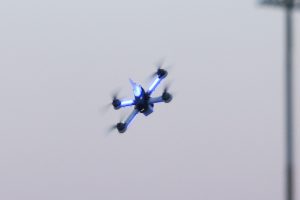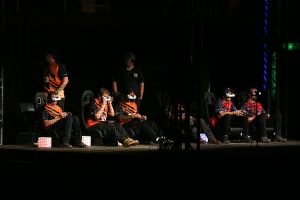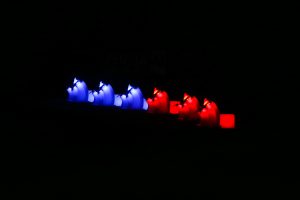- Slug: Sports-Drone Racing Arizona, 740 words.
- 4 photos available (thumbnails, captions below).
By Alyssa Polc
Cronkite News
PEORIA – Drones whipped through the air Saturday at Peoria Sports Complex, where the Arizona Desert Hawks and the Phoenix Falcons competed in Major League Drone Racing’s (MLDR) first live preseason event.
MLDR is a professional American Drone Racing League and new competitive sport where pro pilots go head-to-head racing drones at high speeds through different obstacles while accumulating points throughout 10 heats.
“It (MLDR) is built just like the NFL,” MLDR founder and CEO Richard Tulloch said. “Thirty-two teams, two conferences – Eastern and Western; eight divisions, and there will be a Super Bowl” at the end of the season.
Each drone is controlled by a skilled pilot and maneuvered with a radio transmitter-type controller, as well as FVP-style goggles, that allow the pilot to see from the drone’s eye view. A mixed crowd of about 20 fans could watch the video feed of the onboard drone camera on the jumbotron as each heat began.
The energetic crowd could be heard expressing their excitement for the teams with cheers of, “Let’s go, Falcons,” or “Let’s go, Hawks.” One fan took it to the next level by singling out a bearded pilot with a chant of, “Big beard, big win. Bring it home, baby.”
With passionate cheering comes great motivation for the pilots to zoom through the obstacles within the course quickly and efficiently.
“Tracks are unique pretty much every time,” said Chris “Sturmy” Sturm, who is the Chief Technology Officer and pilot for the Desert Hawks. “They’re usually very dynamic and difficult for the audience to follow around. We made sure to pay close attention to make it easier for everyone to see what’s going on.”
The drones used in Saturday’s race were fresh builds. “I actually built all 60 drones (that were) out there tonight,” Sturmy said. “Takes about three hours per drone. I drove them down from Sedona this morning. I haven’t slept in so long.”
Developing MLDR has been no easy task, and there’s still plenty of work to be done ahead of its first official season. Ideally, MLDR would like each team to have three preseason races under its belt before the regular season, or at least one. However, many teams are still in development.
“We have 11-12 teams built so far,” Tulloch said. “There are a few females within the league – two teams in California have some – and we’re currently building a team in Seattle where there will be another. Unfortunately, there aren’t too many female pilots, so we’re mostly male-dominant. Hopefully, more (females) are interested in the future.”
As for current pilots, each has a unique story that led them to their drone racing journey. One racer who goes by “Scrapheap,” a nickname earned by showing up to meets with half-broken drones, said he saw an “international news program with guys flying drones through a warehouse” that helped pique his interest. Another was surrounded by friends who flew drones and was influenced to try it.
Before MLDR started, many of the pilots found themselves gathering in nearby public spaces to race or fly for fun.
“They (pilots) have been doing this for a while – for years, most of them,” Tulloch says. “(They) would fly around the park … I saw them and thought it (MLDR) was a great idea.”
However, drone racing is more than a fun, competitive sport. It opens the door for opportunity. Many hope the league will help them become better pilots and gain confidence. But for others, it’s a way to help get their lives on a better path.
A pilot by the nickname “Lucid” explained in his introduction video shown ahead of the event how he has had many hardships in his life, from “homelessness, child abuse and neglect.” Now, he is involved with a friendly and supportive community of racers who took him under their wing, helped him get the proper new gear and became a big part of helping turn his “bad story” into something greater.
MLDR radiates positivity through those within the league and its supporters.
“I’m excited to be a part of MLDR,” Desert Hawk pilot Eric “Hatter” Hughes said. “Just to be a part of a team where it’s not necessarily the fastest one that wins, but it’s both the strategy as well as the team goal to get the placements. I’m really excited about that format.”
MLDR will continue to hold preseason races throughout 2023 and 2024 before officially starting its first regular season in 2025.
For more stories from Cronkite News, visit cronkitenews.azpbs.org.



